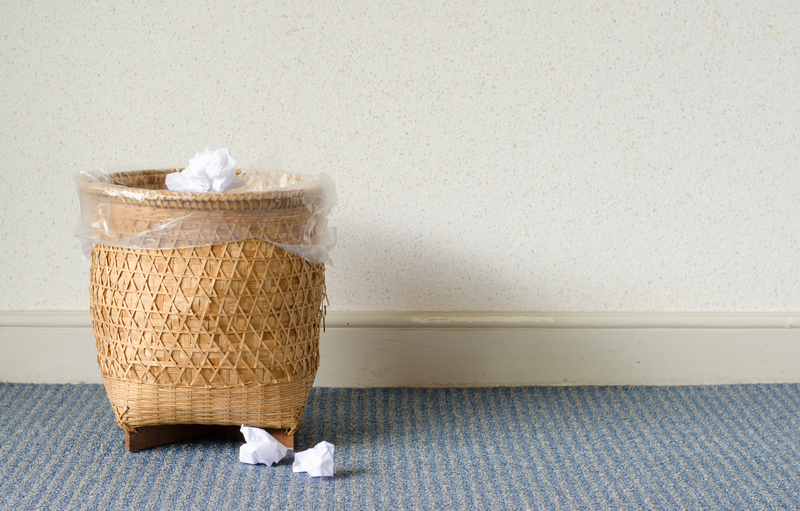Simple Ways to Begin Recycling Paper at Home
Posted on 12/04/2025
Simple Ways to Begin Recycling Paper at Home
Recycling paper is an easy yet impactful way to contribute to environmental sustainability. By incorporating simple practices into your daily routine, you can help conserve natural resources, reduce landfill waste, and lower your carbon footprint. This article will guide you through simple ways to begin recycling paper at home, highlighting practical steps and tips to make the process effective and efficient.
The Importance of Recycling Paper
Understanding the significance of paper recycling is crucial before diving into the methods. Recycling paper helps in reducing deforestation, conserving water, and decreasing greenhouse gas emissions. By recycling one ton of paper, you can save 17 trees, 7,000 gallons of water, 380 gallons of oil, and reduce landfill space by 3 cubic yards.

Step-by-Step Guide to Recycling Paper at Home
1. Set Up a Paper Recycling System
An organized system is key to successful recycling. Start by designating a specific area in your home for paper collection. Use separate bins or containers for different types of paper, such as newspapers, magazines, office paper, and cardboard. Label each bin clearly to avoid confusion and ensure that everyone in the household participates.
2. Educate Your Household
Informing all household members about the importance of recycling and how to do it correctly is crucial. Conduct a small workshop or meeting to explain the types of paper that can be recycled and those that cannot. Encourage everyone to contribute to the recycling effort and reward consistent participation to keep the motivation high.
3. Know What You Can and Cannot Recycle
It's essential to know which types of paper are recyclable and which are not. Recyclable papers include:
- Newspapers
- Magazines
- Office paper and mail
- Cardboard and paperboard
- Books and catalogs
Non-recyclable papers include:
- Paper with food residue
- Waxed or coated paper
- Tissues and paper towels
- Paper with plastic lamination
4. Reduce Paper Consumption
While recycling is essential, reducing paper usage is equally important. Implement strategies to minimize paper waste, such as:
- Using digital alternatives whenever possible
- Printing double-sided documents
- Opting for paperless billing and online subscriptions
- Reusing one-sided printed paper for note-taking
Engage in Composting
Did you know that some types of paper can be composted? Paper with no inks or harmful chemicals, such as plain cardboard or shredded newspaper, can be added to your compost pile. Paper significantly contributes to the carbon content, balancing the green materials in the compost.
Find Local Recycling Centers
Locate a nearby recycling center if your local waste management does not offer curbside pickup for paper recycling. Many centers provide bins for drop-off. Some organizations also organize community recycling events, offering a convenient option for responsible disposal.
1. Visit Your Local Recycling Center
Getting familiar with your nearest recycling facility is another effective step to ensure your collected papers are recycled appropriately. Also, confirm the recycling center's hours and guidelines to avoid any hassles.
2. Utilize Curbside Recycling Programs
Contact your waste management service to inquire about curbside recycling programs. Most municipalities offer these services, making it convenient to recycle without leaving your home. Ensure that you follow their guidelines about sorting and packaging to prevent contamination.
Get Creative with Upcycling
Upcycling paper is a fun and sustainable way to reuse materials, turning waste into value-added products. Here are some ideas:
- Create homemade paper by blending used paper scraps with water
- Use old newspapers for gift-wrapping
- Craft DIY projects like greeting cards, envelopes, or decorative items
- Shred paper to use as cushioning material for shipping packages
Teach Children About Recycling
Educating children on recycling from a young age fosters long-term environmental responsibility. Involve them in sorting paper, explaining the importance of recycling, and encouraging them to come up with creative upcycling projects. Use educational resources such as books, documentaries, and interactive websites to make learning engaging.
1. Recycling Games and Activities
Engage children in fun recycling games and activities. Create a scavenger hunt where they find recyclables around the house, or have them create art projects from recycled paper. Making the process enjoyable will instill positive habits and knowledge.
2. Field Trips and Workshops
Organize field trips to recycling centers or environmental workshops to provide a hands-on learning experience. Seeing the recycling process first-hand can significantly impact children, making them more conscious of their waste and recycling efforts.

Monitor and Improve Your Efforts
Continuous assessment of your recycling practices ensures effectiveness. Keep track of the amount of paper your household recycles and set goals for improvement. Encourage feedback and suggestions from household members to refine and enhance your recycling system.
1. Track Your Progress
Maintain a recycling log to track the volume of paper recycled each month. This will help you assess your progress and identify areas for improvement. Celebrate milestones to motivate and reinforce the importance of recycling.
2. Stay Updated on Recycling Practices
Recycling guidelines and technologies are continually evolving. Stay informed about the latest developments and best practices in paper recycling through reputable sources, like environmental organizations and local waste management authorities. Adapting to new methods enhances the efficiency of your efforts.
Conclusion
Recycling paper at home is a simple yet impactful way to contribute to environmental sustainability. By setting up an organized collection system, educating your household, and engaging in creative upcycling, you can significantly reduce your paper waste. Remember to familiarize yourself with local recycling centers and curbside programs to ensure proper disposal. Continuously monitoring and improving your efforts will make recycling a rewarding and effective practice. Start today and make a positive difference for the planet!










